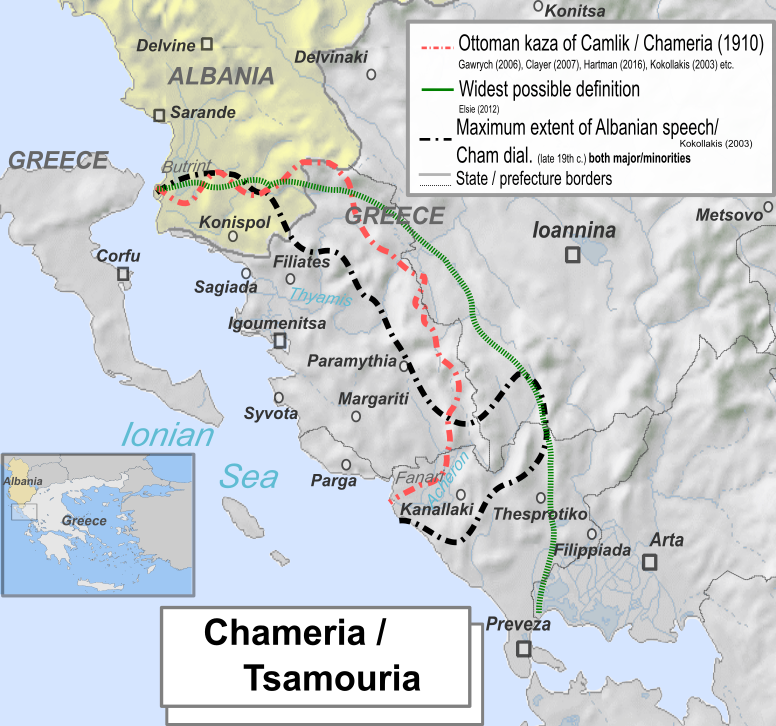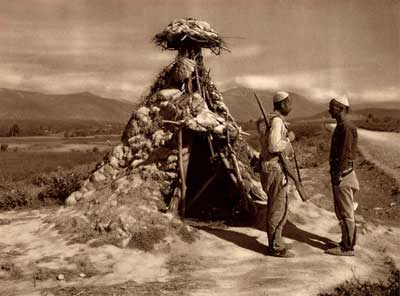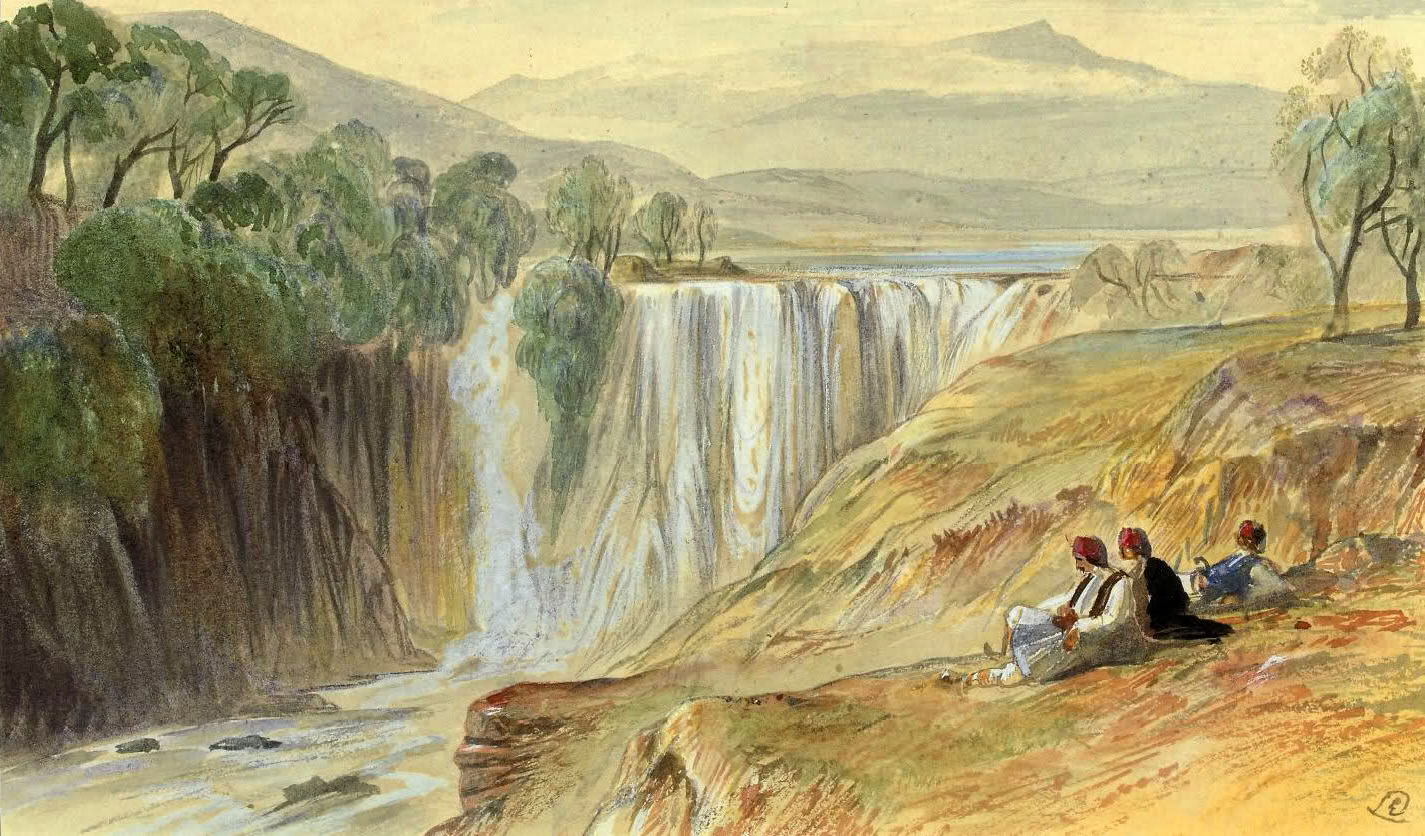|
Osman Taka
Osman Resul Taka (died 1887) was a Cham Albanian dancer and unclear personage from 19th century. The Dance of Osman Taka is named after him. His early life is not clear. He belongs to the Taka clan of Filiates, also known for Alush Taka, an Albanian patriot. According to narrative sources, his name became well-known during the mid 19th century. He was probably a ''kachak'' or ''klepht'' fighting the Ottomans in Chameria region. Other sources connect him with the Albanian National Awakening of late 19th century. He was jailed in Yanina and was sentenced to death. When he was asked to give his final wish, he wanted to dance. The folk tradition says that his dance was so beautiful that the local Albanian gendarmes of the Ottoman army, did not execute him. After some days he was caught again and was killed in Konispol Konispol ( sq-definite, Konispoli) is the southernmost town in Albania. It sits one kilometer away from the Border crossings of Albania, Albanian-Greek border. The set ... [...More Info...] [...Related Items...] OR: [Wikipedia] [Google] [Baidu] |
Dance Of Osman Taka
The Dance of Osman Taka ( sq, Vallja Çame e Osman Takës); el, Οσμαντάκας or Σαμαντάκας) is a traditional dance in Albania and Greece. In Albania it is mainly danced by Cham Albanians. The dance bears the name of Osman Taka, a 19th-century Muslim Cham Albanian guerilla fighter who fought against Ottoman forces. It is a famous variation from the Albanian Cham repertoire of the older ''Çamçe'' dance. Background Osman Taka was jailed in Yanina and was sentenced to death. When he was asked to give his final wish, he wanted to dance. The folk tradition says that his dance was so beautiful that the local Albanian gendarmes of the Ottoman army, did not execute him. After some days he was caught again and was killed in Konispol while fighting against Ottoman authorities . Performance The dance follows a strict tempo with emphasis in the "attitude, style and grace" of the dancer. It is a meter with steps "slow-quick-quick". The dance is a row dance, with a lead ... [...More Info...] [...Related Items...] OR: [Wikipedia] [Google] [Baidu] |
Cham Albanians
Cham Albanians or Chams ( sq, Çamë; el, Τσάμηδες, ''Tsámidhes''), are a sub-group of Albanians who originally resided in the western part of the region of Epirus in northwestern Greece, an area known among Albanians as Chameria. The Chams have their own particular cultural identity, which is a mixture of Albanian and Greek influences as well as many specifically Cham elements.See Hasluk, 'Christianity and Islam under the Sultans', London, 1927. A number of Chams contributed to the Albanian national identity and played an important role in starting the renaissance of the Albanian culture in the 19th century. The Chams speak their own dialect of the Albanian language, the Cham Albanian dialect, which is a Southern Tosk Albanian dialect and one of the two most conservative ones; the other being Arvanitika. During the late 1930s Chams suffered from intimidation and persecution under the dictatorship of General Metaxas. Following the Italian occupation of Albania in ... [...More Info...] [...Related Items...] OR: [Wikipedia] [Google] [Baidu] |
Filiates
Filiates ( el, Φιλιάτες; ) is a town and a municipality in Thesprotia, Greece. It is located in the northernmost part of the regional unit, bordering western Ioannina regional unit and southern Albania. Name The region of Filiates was known as Cestrine prior to the Ottoman period. The region is named for the ancient town of Cestria, in ancient Epirus, other ancient names for which were Cammania, Ilion, Epirus, Troy, Epirus and Troia and Epirusis; the site of ancient Cestria is probably over the Albanian frontier. The modern name Filiates is the result of the conversion of a surname. According to Eqrem Çabej, Idriz Ajeti and Ali Dhrimo, it contains the Albanian suffix -at, widely used to form toponyms from personal names and surnames. According to Konstantinos Giakoumis, it applies to a certain ''Filios'' with the addition of the Greek ending -άτες or -άταις. Filiates is known as Filat in Albanian, "Filiates (alb. Filat)" and as Filat in Ottoman Turkish. "Filat" ... [...More Info...] [...Related Items...] OR: [Wikipedia] [Google] [Baidu] |
Alush Taka
The Stations of the Exodus are the locations visited by the Israelites following their exodus from Egypt, according to the Hebrew Bible. In the itinerary given in Numbers 33, forty-two stations are listed, although this list differs slightly from the narrative account of the journey found in Exodus and Deuteronomy. Biblical commentators like St Jerome in his ''Epistle to Fabiola'', Bede (''Letter to Acca: "De Mansionibus Filiorum Israhel"'') and St Peter Damian discussed the Stations according to the Hebrew meanings of their names. Dante modeled the 42 chapters of his ''Vita Nuova'' on them. Sources According to the documentary hypothesis, the list of the Stations was originally a distinct and separate source text. Proponents of this hypothesis believe that the redactor, in combining the Torah's sources, used parts of the Stations list to fill out awkward joins between the main sources. However, a slightly variant version of the list appears in full at Numbers 33, and several ... [...More Info...] [...Related Items...] OR: [Wikipedia] [Google] [Baidu] |
Kachak
Kachaks ( sq, kaçak, sr, качаци / ''kačaci'') is a term used for the Albanian bandits active in the late 19th and early 20th century in northern Albania, Montenegro, Kosovo and Macedonia, and later as a term for the militias of Albanian revolutionary organizations against the Kingdom of Serbia (1910–18) Kingdom of Yugoslavia (1918–24), called the "Kaçak movement". Etymology The word is derived from Turkish '' kaçmak'' for "outlaw". Background History 1920–24 Kachak movement The Committee for the National Defense of Kosovo () was created in Shkodër, under Hasan Prishtina, in 1918. The committee organizationally and financially supported the kachaks in Albanian-populated areas of Yugoslavia, in Kosovo and Skopje (the former Kosovo Vilayet). Kachaks were also active around Ohrid and Bitola. On 6 May 1919 the Committee called for a general uprising in Kosovo and other Albanian-inhabited regions in Yugoslavia. The Kachaks were popular among Albanians, and local s ... [...More Info...] [...Related Items...] OR: [Wikipedia] [Google] [Baidu] |
Klepht
Klephts (; Greek κλέφτης, ''kléftis'', pl. κλέφτες, ''kléftes'', which means "thieves" and perhaps originally meant just "brigand": "Other Greeks, taking to the mountains, became unofficial, self-appointed armatoles and were known as klephts (from the Greek ''kleptes'', "brigand").") were highwaymen turned self-appointed armatoloi, anti-Ottoman insurgents, and warlike mountain-folk who lived in the countryside when Greece was a part of the Ottoman Empire. They were the descendants of Greeks who retreated into the mountains during the 15th century in order to avoid Ottoman rule.: "The klephts were descendants of Greeks who fled into the mountains to avoid the Turks in the fifteenth century and who remained active as brigands into the nineteenth century." They carried on a continuous war against Ottoman rule and remained active as brigands until the 19th century. The terms kleptomania and kleptocracy are derived from the same Greek root, κλέπτειν (''klépte ... [...More Info...] [...Related Items...] OR: [Wikipedia] [Google] [Baidu] |
Ottoman Empire
The Ottoman Empire, * ; is an archaic version. The definite article forms and were synonymous * and el, Оθωμανική Αυτοκρατορία, Othōmanikē Avtokratoria, label=none * info page on book at Martin Luther University) // CITED: p. 36 (PDF p. 38/338) also known as the Turkish Empire, was an empire that controlled much of Southeast Europe, Western Asia, and Northern Africa between the 14th and early 20th centuries. It was founded at the end of the 13th century in northwestern Anatolia in the town of Söğüt (modern-day Bilecik Province) by the Turkoman tribal leader Osman I. After 1354, the Ottomans crossed into Europe and, with the conquest of the Balkans, the Ottoman beylik was transformed into a transcontinental empire. The Ottomans ended the Byzantine Empire with the conquest of Constantinople in 1453 by Mehmed the Conqueror. Under the reign of Suleiman the Magnificent, the Ottoman Empire marked the peak of its power and prosperity, as well a ... [...More Info...] [...Related Items...] OR: [Wikipedia] [Google] [Baidu] |
Chameria
Chameria ( sq, Çamëria; el, Τσαμουριά, ''Tsamouriá''; tr, Çamlık) is a term used today mostly by Albanians to refer to parts of the coastal region of Epirus in southern Albania and Greece, traditionally associated with the Albanian ethnic subgroup of the Chams.Elsie, Robert and Bejtullah D. Destani (2012). ''The Cham Albanians of Greece: A Documentary History''. IB Tauris. . p. XXIX. "Chameria is a mountainous region of the southwestern Balkan Peninsula that now straddles the Greek-Albanian border. Most of Chameria is in the Greek Province of Epirus, corresponding largely to the prefectures of Thesprotia and Preveza, but it also includes the southernmost part of Albania, the area around Konispol. It is approximately 10,000 square kilometres in size and has a current, mostly Greek-speaking population of about 150,000. As an historical region, Chameria, also spelled Chamuria, Chamouria or Tsiamouria, is sometimes confused with Epirus which is in fact a much larger a ... [...More Info...] [...Related Items...] OR: [Wikipedia] [Google] [Baidu] |
Albanian National Awakening
The Albanian National Awakening ( sq, Rilindja or ), commonly known as the Albanian Renaissance or Albanian Revival, is a period throughout the 19th and 20th century of a cultural, political and social movement in the Albanian history where the Albanian people gathered strength to establish an independent cultural and political life as well as the country of Albania. Prior to the rise of nationalism, Albania remained under the rule of the Ottoman Empire for almost five centuries and the Ottoman authorities suppressed any expression of national unity or national conscience by the Albanian people. There is some debate among experts regarding when the Albanian nationalist movement should be considered to have started. Some sources attribute its origins to the revolts against centralisation in the 1830s, others to the publication of the first attempt by Naum Veqilharxhi at a standardized alphabet for Albanian in 1844,Zhelyazkova, Antonina (2000). "Albanian Identities". Sofia: ... [...More Info...] [...Related Items...] OR: [Wikipedia] [Google] [Baidu] |
Ioannina
Ioannina ( el, Ιωάννινα ' ), often called Yannena ( ' ) within Greece, is the capital and largest city of the Ioannina regional unit and of Epirus, an administrative region in north-western Greece. According to the 2011 census, the city population was 65,574, while the municipality had 112,486 inhabitants.GOV. results of permanent population 2011, p. 10571 (p. 97 of pdf), and in Excel formatTable of permanent population 2011 from the sitHellenic Statistical Authority 24 November 2017. Retrieved 2018-01-09. It lies at an elevation of approximately above sea level, on the western shore of |
Konispol
Konispol ( sq-definite, Konispoli) is the southernmost town in Albania. It sits one kilometer away from the Border crossings of Albania, Albanian-Greek border. The settlement is inhabited by Muslim Cham Albanians. Konispol is the modern centre of the Cham Albanian community in Albania. The main economic interests of Konispol are agriculture and viticulture. The town is the seat of the southernmost administrative unit in Albania, the Municipality of Konispol ( sq, Bashkia Konispol). It was formed during the 2015 local government reform by the merger of the former municipalities of Konispol, Markat and Xarrë. The total population is 8,245 (2011 census), in a total area of 226.26 km2. The population of the former Konispol municipality at the 2011 census was 2,123. The former Konispol municipal unit (pre-2015) consisted of the town Konispol and the village Çiflik. The new larger municipality of Konispol contains settlements that are inhabited by Albanians who form the majority ... [...More Info...] [...Related Items...] OR: [Wikipedia] [Google] [Baidu] |
1887 Deaths
Events January–March * January 11 – Louis Pasteur's anti-rabies treatment is defended in the Académie Nationale de Médecine, by Dr. Joseph Grancher. * January 20 ** The United States Senate allows the Navy to lease Pearl Harbor as a naval base. ** British emigrant ship ''Kapunda'' sinks after a collision off the coast of Brazil, killing 303 with only 16 survivors. * January 21 ** The Amateur Athletic Union (AAU) is formed in the United States. ** Brisbane receives a one-day rainfall of (a record for any Australian capital city). * January 24 – Battle of Dogali: Abyssinian troops defeat the Italians. * January 28 ** In a snowstorm at Fort Keogh, Montana, the largest snowflakes on record are reported. They are wide and thick. ** Construction work begins on the foundations of the Eiffel Tower in Paris, France. * February 2 – The first Groundhog Day is observed in Punxsutawney, Pennsylvania. * February 4 – The Interstate Commerce Act ... [...More Info...] [...Related Items...] OR: [Wikipedia] [Google] [Baidu] |







